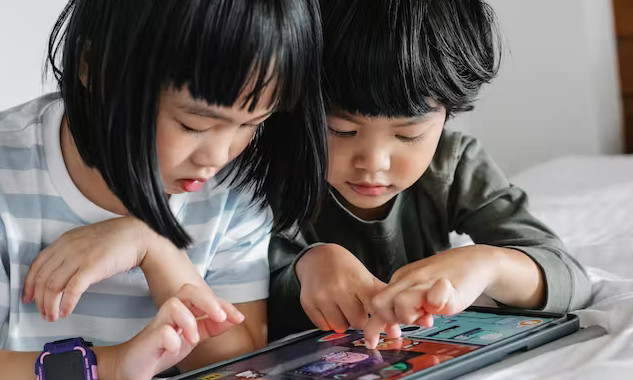Many parents worry about how much time their children spend watching screens. While some time on devices is fine for entertainment and education, we also know it is important children do things away from TVs and devices.
This means for many families, there is a daily battle around getting kids off their screens and avoiding “tech tantrums”.
Our new research looks at how parents and carers can help children with what researchers call “technology transitions”.
Why are transitions so tough?
Technology transitions are a lot like other transitions children experience throughout their day.
These include stopping play to get dressed, moving from having breakfast to getting in the car, or finishing time on the swing to leave the park. These can be tricky because they involve self-regulation skills that children learn and develop as they grow.
Transitioning from screen to non-screen activities is something many children would do more than once a day.
Often technology transitions can appear harder for children and their carers than other transitions because devices can be highly engaging, with developers and media designers actively working to keep children connected (think of how streaming services automatically start playing the next show and display all the similar options for viewing).
Our study
We are working on a larger project to develop an online tool with advice for parents about using digital technologies with their children.
In this part of the study, we have been exploring how to support children with technology transitions. Together with Playgroup WA, we worked with a group of 14 parents to explore different ways to move children off technology.
Over 12 weeks, we provided parents with ideas and advice to support transitions and then asked them what worked best. These resources included content from the federal government’s parenting website Raising Children Network and ABC Kids.
Families reported their top three strategies for supporting technology transitions.
1. Prepare your kids
We would be upset if we were watching a movie and someone suddenly stopped it midway through without warning.
Just like adults, children can feel very annoyed and frustrated when their device is suddenly taken away, especially when they are enjoying a game or watching content they like.
So you need to prepare children and let them know when their time with a screen will end.
Some successful strategies parents and carers in this research used were “you can watch two episodes of this show” or “when this game is finished we will stop”. These help children to know how much time they will have with a device and that they will be able to finish an activity they are enjoying.
Telling them what activity would follow was also helpful. For example “when you have finished that game it will be time to eat” or “after you have watched that show we will go to the park”. What they are moving to may not always be fun, helping children understand what to expect helps make for a smoother transition.
2. Do something ‘for real-life’ inspired by the screen
You can use children’s interests in what they are watching to help them move from technologies into non-digital activities.
For example if your child has been watching Bluey you could invite them to complete a Bluey puzzle, or role-play some Bluey games such as keepy uppy or obstacle course. Families in this study reported moving from watching Fireman Sam to visiting a fire station or building a fire station with their child using blocks and other play materials in the home.
Parents also successfully used music and songs children liked to help with technology transitions. This could be playing music from a show, or turning on music kids liked to act as a fun activity to engage them in something else.
3. Give kids choice
Offering children choice in these situations can also be very powerful.
Many aspects of children’s lives are managed for them, when to go to school or pre-school, what they have to wear and using a seat belt in the car. Many of these things are not negotiable and often for good reasons.
This is why it is helpful to give children some choice in their lives when you can.
Parents reported success when providing kids with simple choices when preparing to move off technology. For example “would you like to watch two or four episodes of this show?” or “would you like to start the timer for your game or do you want me to let you know when your time is up?”
These strategies help children feel like they have some choice about how long they will use technologies.
As parents and carers navigate screens and technology with their kids, they should know they are not alone if they find transitions difficult. And there are strategies that can help
Juliana Zabatiero, Research Fellow, Curtin University; Kate Highfield, Associate Professor, Early Childhood Education Academic Lead, University of Canberra; Leon Straker, Professor of Physiotherapy, Curtin University, and Susan Edwards, Professor of Education, Australian Catholic University
This article is republished from The Conversation under a Creative Commons license. Read the original article.

Related Books:
Here are 5 non-fiction books on parenting that are currently Best Sellers on Amazon.com:The Whole-Brain Child: 12 Revolutionary Strategies to Nurture Your Child's Developing Mind
by Daniel J. Siegel and Tina Payne Bryson
This book provides practical strategies for parents to help their children develop emotional intelligence, self-regulation, and resilience using insights from neuroscience.
Click for more info or to order
No-Drama Discipline: The Whole-Brain Way to Calm the Chaos and Nurture Your Child's Developing Mind
by Daniel J. Siegel and Tina Payne Bryson
The authors of The Whole-Brain Child offer guidance for parents to discipline their children in a way that promotes emotional regulation, problem-solving, and empathy.
Click for more info or to order
How to Talk So Kids Will Listen & Listen So Kids Will Talk
by Adele Faber and Elaine Mazlish
This classic book provides practical communication techniques for parents to connect with their children and foster cooperation and respect.
Click for more info or to order
The Montessori Toddler: A Parent's Guide to Raising a Curious and Responsible Human Being
by Simone Davies
This guide offers insights and strategies for parents to implement Montessori principles at home and foster their toddler's natural curiosity, independence, and love of learning.
Click for more info or to order
Peaceful Parent, Happy Kids: How to Stop Yelling and Start Connecting
by Dr. Laura Markham
This book offers practical guidance for parents to shift their mindset and communication style to foster connection, empathy, and cooperation with their children.























